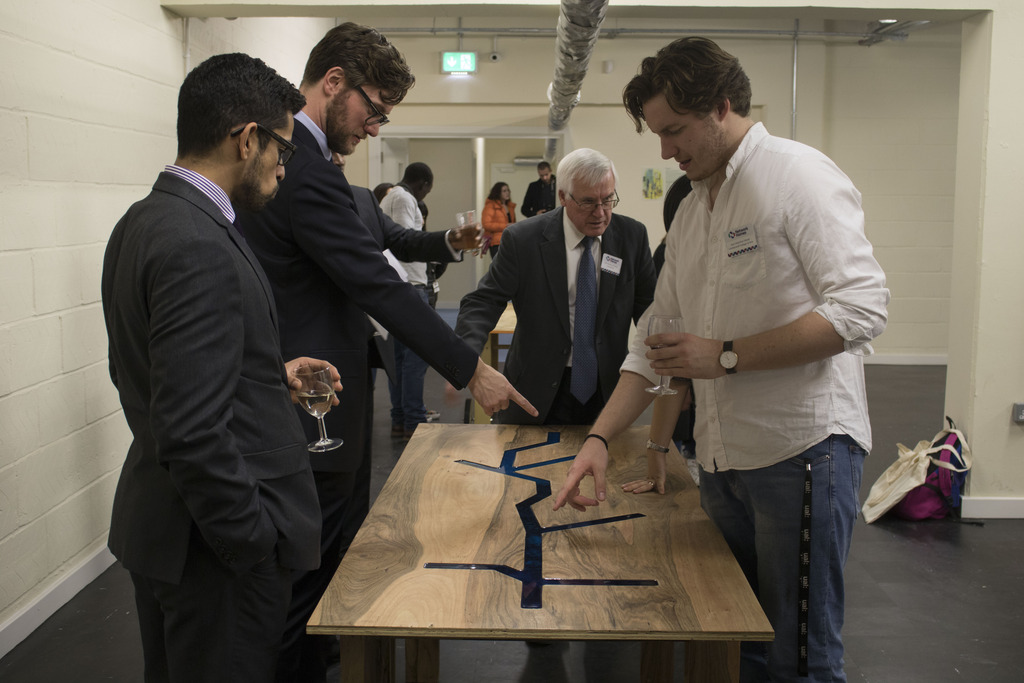Camberwell’s BA 3D Design first years were set the project ‘Autoprogettazione’ to work in small teams and make reproductions of a selected table by Italian modernist artist and furniture designer Enzo Mari. The replica tables will be part of the new Stockwell Park Estate Community Centre.
“A project for making easy-to-assemble furniture using rough boards and nails. An elementary technique to teach anyone to look at present production with a critical eye.” Enzo Mari
BA 3D Design lecturer Fabiane Lee-Perrella talked us through the project brief, answered questions for us about the project and also told us a bit about herself.
“Autoprogettazione is translated as, auto = self and progettazione = design. The term ‘self-design’ is misleading since the word ‘design’ to the general public now signifies a series of superficially decorative objects. Enzo Mari defines autoprogettazione as an exercise carried out individually, to improve one’s personal understanding of the sincerity behind the project. To make this possible you are guided through an archetypal and very simple technique. Therefore the end product, although usable, is only important because of its educational value.
The students were told that their tables must include the following processes and materials; nails, screws, dowels, biscuit joints and wood cut in different angles. Instructions given to the students were to consider shapes, materials, overall patterns and also how the table will be used in the community centre before deciding on its finish. Each team member had to produce a specification drawing of the final table including all materials, techniques and finish. Finally the students were advised to use this opportunity to learn about wood, again considering the type of wood but also its aesthetic impact.”
Can you tell us about the project – how did it start?
Early in the year I normally run a project that focus on acquiring basic making skills alongside other projects that allow students to explore a range of methodologies in order to develop their creative process.
For the past three years the students have worked in groups to make a range of ‘Autoprogettazione’ furniture pieces by the iconic Italian design Enzo Mari. In his 1974 manual ‘Autoprogettazione’ Enzo offered 19 designs using off-the-shelf timber to build tables, chairs, bookshelves, and even beds. Enzo Mari essentially open-sourced the home furnishings industry.
This time however, I asked our student to adapt one of the seven tables from the ‘Autoprogettazione’ manual and tailor it to the needs of the people who use the facilities at Stockwell Park Community Centre. It was crucial for this project that the students made themselves familiar with the needs and wishes of real people in a real community setting.
Did you have expectations of how the group would handle the brief?
Our students generally enjoy acquiring new making skills. The challenge here, especially for first year students, was that the focus of the project was understanding and delivering an outcome that met the needs of a community that they didn’t know and that had very different requirements to their own. My hope was that they were able to detach from their own views and needs and learn to be generous as designers and focused on somebody else.
Working with the students I found they are a great bunch, and delivered the tables to the centre with a very professional attitude.
Did you have a particular highlight of the project?
I was ecstatic by how seriously the students took the task and how dedicated they were. Some of the groups superseded my expectations by committing to learning and developing new skills beyond what was asked of them. They derived good quality, useful tables that were totally bespoke to the community centre, but above all some of the tables are beautiful.
Has there been feedback about the tables so far?
The feedback on the opening event at the new centre was extremely positive. The students will also work on video interviews with the people who have been using the tables in the centre. The brief asks the students to obtain a feedback from two users focusing on the qualities and attributes of each table, but also find out how it could be improved.
Finally, Fabiane please tell us a bit about yourself and your practice?
I am a designer, artist and lecturer and also the founder of Flour Studio. Flour is a London based studio working across the fields of public art, design and social inclusion. The studio is actively evolving a new type of creative practice that reaches beyond specialist boundaries. Flour Studio is committed in creating work through a collaborative practice where the audience is engaged directly in the creative process and participants are encouraged to become co-authors and editors, as well as the spectators of the work.
I have been teaching on the BA 3D Design course at Camberwell since 2004 and in 2006 I have been mostly working with the first year students. While working at UAL I co-founded the Early Lab. The Early Lab is a design for social innovation practice working cross-university transdisciplinarily. I am also a researcher interested in direct, on-the-ground research with communities. For the last 10 years I have explored the role of art and design in innovating people’s participation and personal investment in creative work for the public realm.
I have 12 years’ experience of working collaboratively with communities, schools and the public for museums and cultural centres, public art commissioners, local councils, place-making agencies and charities. Clients and project partners have included: Refugee Council, Southbank Centre, Barbican Centre, Lambeth Council, Future City, Allen & Overy, Crossway Foundation and schools throughout the country.
All photos by Imanol Torre Asenjo.
Related links










